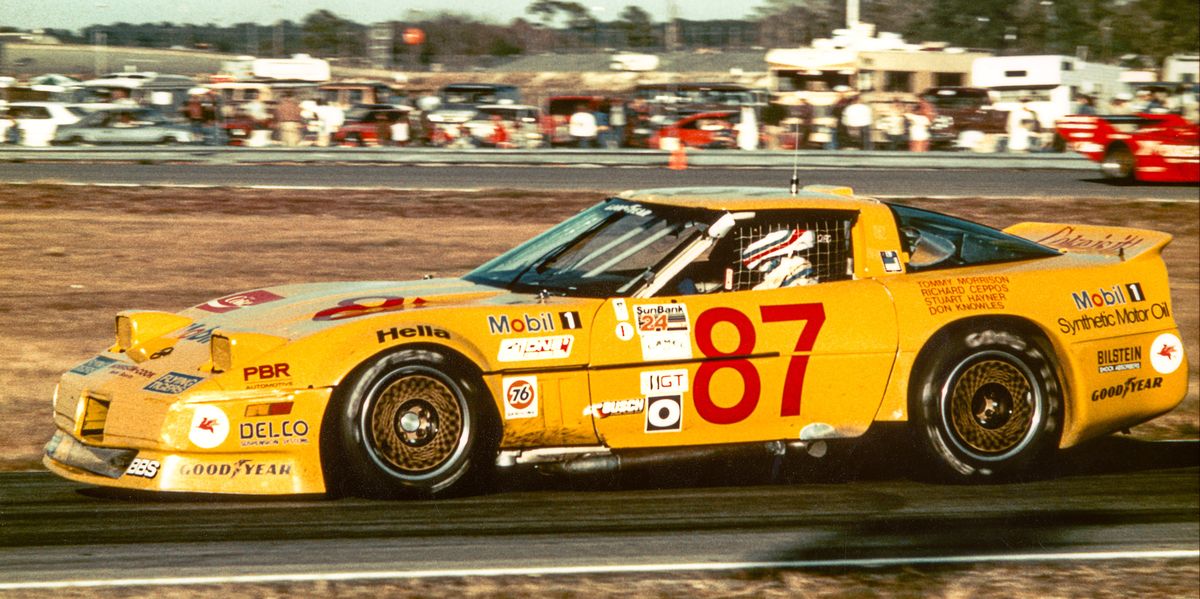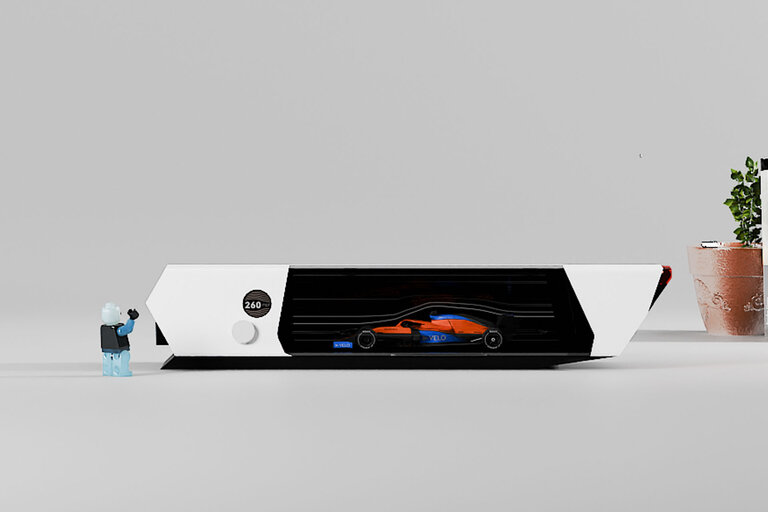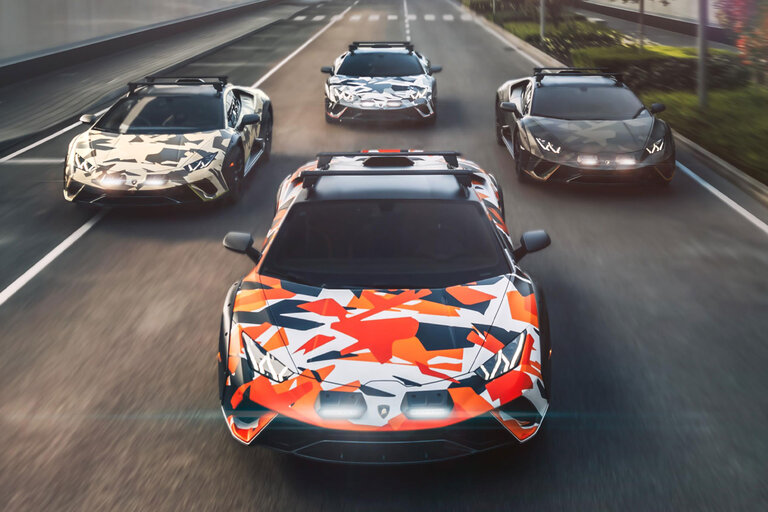
One of my prized possessions is this photo of a school-bus-yellow C4 Corvette race car that I drove in the 24 Hours of Daytona in 1987. That’s me behind the wheel, about to turn left and climb up onto Daytona International Speedway’s high-banked Turn 1. In the background is a blurry red race car, most likely the famous Coca-Cola–sponsored Porsche 962 GTP prototype co-driven by sports car and Formula 1 superstar Hans-Joachim Stuck. Every time I look at that photo I feel a thrill from knowing that I had been on the inside of one of the great top-level professional sports car endurance races rather than at home watching it on TV. I came back to Daytona for this year’s running—now sans race suit and helmet—to see what has changed and what hasn’t. And also to remember what it was like to be there in the middle of it all, out on the track with my racing heroes.
The 24 Hours of Daytona, like those of us who have aged more than three decades, is both the same and different than it used to be. The 3.56-mile infield road course, which utilizes almost all of the 2.5-mile oval that surrounds it, hasn’t changed except for revisions to the curbs. Some new buildings aside, Daytona still feels as imposing as it did when I first rolled into the infield garage area years ago. Standing there again today, the immense grandstands, which can seat more than 100,000 fans, tower over you; you’re an ant at the bottom of an empty swimming pool. You can almost feel the racing history embedded in the tarmac and gouged into walls that line the oval. The facility opened in 1959, but it’s been eating right and working out; it’s in great shape. If only we all could age as gracefully.
The Daytona 24-hour endurance race, now called the Rolex 24 at Daytona, kicks off the pro-racing season as surely as Memorial Day marks the start of summer. And with similar anticipation of good times to come. Down in the garages the morning of the race, the 24-hour has a party feel. There’s lots of hard work going on around the cars, but also a lot of smiles and laughter from the crews, drivers, and team owners. I remember that, plus being keyed up for the biggest race of my life.
Race-team owner Chip Ganassi, who had two Cadillac GTP cars entered in the top class at this year’s event, confirmed that the lighthearted vibe is still alive. “The drivers love this race. It’s fun for them. It’s the beginning of the season. They get to see their friends from around the world. They’re happy. No one’s cranky and stressed out like they are at the end of the season when they’re trying to win a championship.” Ganassi would know; his IndyCar and endurance-racing teams have 19 series championships between them.
The 24 Hours remains an event that draws drivers from other racing disciplines beyond sports cars. When I raced, I was geeked to know that legends like A.J. Foyt, Al Unser, and Danny Sullivan were competing in the GTP class. NASCAR stars Darrell Waltrip, Bill Elliott, and Terry Labonte were in the field, as was Jim Downing, co-creator of the HANS device. A former Olympian turned race driver named Bruce Jenner was pedaling a Mustang in my class. I was on the prowl for them; I did see A.J. in pit lane before the race, climbing out of his Porsche 962.
It was the same in 2023. Among the big names this year were IndyCar champions Scott Dixon, Josef Newgarden, Sébastien Bourdais, and Simon Pageneaud along with four-time Indy 500 winner Helio Castroneves. NASCAR driver Austin Cindric and former Formula 1 driver (and current IndyCar shoe) Romain Grosjean were both in the show. Yes, I did get a glimpse of a couple of them.
As the race unfolded, I watched from a spot just behind the starter’s stand at the start-finish line. The top-class GTP cars coming at me at 200 mph while weaving through clumps of competitors from the slower classes were breathtaking. Had I really been out there mixing it up in the middle of that? It was hard to believe. It didn’t seem that hectic when I was driving, and probably wasn’t. The cars run harder and closer today.
Sports-car racing is messy as well as exciting for fans because of the multiple classes, which circulate at different speeds. Simplified to its basic structure, there are two types of race cars in endurance races like the 24 Hours of Daytona: prototypes, which look like fighter jets on four wheels or grown-up Hot Wheels cars; and Grand Touring (GT) cars, which are based on easily identifiable production models like the Corvette Z06, Porsche 911, Ferrari 296, Lamborghini Huracán, and several others.
The prototypes are split into three classes in ascending order of horsepower and speed, with GTP at the top. Both of the GT classes, one for pros and one for a mix of pros and semi-pros, are now composed of cars that meet the FIA’s global GT3 race-car specs. Like them, my C4 Vette racer started life as a production car—though it was the only car in what was then called the GTO class that wasn’t a purpose-built, tube-frame racing machine hiding under fake production-car bodywork. The GT rules now prohibit those sorts of purebred racing machines.
My Vette’s production-car roots made us one of the slower cars in the race that year, not that I cared. I was out there, wide-eyed and loving it. Driving in the race didn’t seem nearly as dicey as watching today’s shoes go at it from the sidelines. The Daytona road course is simple and easy to learn, though braking hard from 160 mph into Turn 1 and then again into the back straight’s Le Mans chicane while simultaneously turning and downshifting—without the benefit of today’s anti-lock brakes, paddle shifters, or high-downforce aerodynamics—demanded I focus with every fiber of my being in order to do it each lap without spinning out.
I think what made the racing easier than I expected was the quality of the drivers. I’d been racing for 14 years in the amateur ranks, but it took about two laps into my first afternoon stint to determine my fellow competitors were the best I’d ever been on a track with. So, this was what it was like racing with pros. If they were going to pass you it was quick, clean, and as decisive as a karate chop to the top of a table. Bam! They were up next to you and gone. I got passed in Turn 1 by the Coca-Cola 962 so aggressively that it had to have been Hans Stuck at the wheel. Of course, I had no way of knowing it was actually him, but I’ve held on to that belief ever since. And in my fantasy, I am honored.
With the GTP cars going 210 mph on the straights and our car only capable of 160, I scanned the mirrors constantly and stayed out of the way on the high-speed oval sections, always leaving the lane closest to the wall open as I’d been told to do. Embarrassing disclosure: after running some laps in my first stint and getting almost comfortable, I realized that the two places where I climbed onto the track’s 31-degree banking could afford me the opportunity for additional celebrity stalking. When any of the GTP competitors would accelerate past, I’d steal a peek into their car, hoping to see which famous driver was behind the wheel. No luck. Insert laughing emoji here.
While much of the atmosphere and on-track action in 2023 seemed similar to what I experienced more than three decades ago, the one thing that has changed radically—and not surprisingly—is the technology in the cars. The GT cars benefit from advances we couldn’t have conceived of in 1987: paddle-shifted gearboxes, driver-adjustable ABS and traction control, incredibly sticky tires, plus picnic-table-size rear wings and other aerodynamic appendages that jam the car into the pavement with huge amounts of downforce. That’s why the GT cars are about 17 seconds per lap faster than our old Vette, a massive improvement in racing terms considering that they don’t have much more than the 500 horsepower my race car did. Their speed comes from their ability to brake impossibly late and corner infinitely harder. It was shocking to see how much farther they could bore into Turn 1 before their brake lights blinked on.
A Debut for Hybrids in GTP
This year was also the first time hybrid technology was allowed in the GTP class. The hybrid systems don’t work anything like they do in passenger vehicles, and the way that the rules require the electrical energy to be deployed and monitored are so complicated, only an engineer can understand it. The GTP cockpits sport so many switches that they look more like an Apollo space capsule inside than a race car. Which is why BMW, Porsche, Cadillac, and Acura got into this year’s race with cars largely built in-house: only automakers have the massive engineering resources needed to make these complex race cars work. Despite the extreme tech, the rules are structured such that the hybrid GTP cars were no faster on the straights than the ones I raced with, though the new cars were about seven and a half seconds quicker than the oldies in race trim.
The other result of technology change is the massive improvement in the race cars’ reliability. In the ’87 race we drove to a pace that was about four seconds slower than the car was capable of. The intention was to keep from overstressing the mechanicals and give the two Corvettes entered by the small Morrison-Cook racing team the best chance of surviving the event intact. Most competitors at that time did something similar.
It didn’t help. My car went out with a terminal engine problem at the 16-hour mark, 337 laps in, having covered some 1200 miles. Our other car fared even worse, not making it past the 77th lap, after just 274 miles.
That year, 36 of 69 starters—52 percent—went out with mechanical woes. In 2023 only 11 of the 61 starters—a mere 18 percent—failed to finish due to mechanical woes despite being driven as fast as they can go every lap. It’s been that way for some years now, as confirmed by Cadillac GTP driver Alex Sims.”Oh, yeah,” he said nonchalantly before the race, “we run flat out every lap.” That made it all the more remarkable that the new hybrid GTP cars held up so well in their inaugural outing.
The 2023 Results
Eight of the nine GTPs entered finished the race, six of them with no mechanical issues. The top four were on the same lap at the checkered, within 11 seconds of one another, having raced for 2787 miles—about the distance from New York City to Los Angeles. The two Acura ARX-06 GTPs finished one-two overall; the two Cadillac V-LMDh cars from the Ganassi team were third and fourth. Whelen Engineering Racing’s Caddy V-LMDh was fifth overall, followed by BMW’s M Hybrid V8 GTP in sixth overall. The three other hybrid GTPs were further down the order. Each of the four other classes crowned winners as well.
Exactly how I got invited to drive in the 1987 race in the first place has gotten lost in the deep recesses of my memory, even as my brain has somehow kept key moments of that weekend alive in a file of vivid mental snapshots. I’ve done a lot of racing since, piling up about 20 24-hour events in the amateur and semi-pro ranks. Though I’ve never won any, I have felt the sweet, exhausted joy that comes from the shared team effort it takes to simply make it to the finish.
So, to win at Daytona must feel monumental. I can say from experience that just being there was something special, a warm feeling that I’ll have with me always.
#Return #Hours #Daytona
Source link







